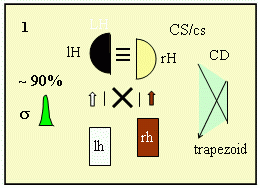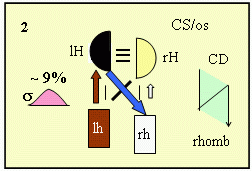|
Evolutionary
Theories of Asymmetrization of Organisms, Brain and Body
(IV)

Right and left-handedness are not the norm and
pathology. They both are normal, adaptive
phenotypes for stable and variable environment, regulating
behavioral plasticity of the society.
The main distinction from all the existing theories is that
handedness is considered in relation to the dominant
hemisphere (as cis- and trans-handedness), and
not to the side of the body (left and right handedness).
People with right hemisphere dominance are rare (less than
1% of the population), therefore they will not be
considered. People with left hemisphere dominance can be
further subdivided according to the position of their
dominant hand, which can be located on the opposite to the
dominant hemisphere side of the body (discordant or
trans-position), or on the same side (concordant or
cis-position):
Left Hemisphere Dominance with Right Hand Dominance
(trans-position,
~90%
of the population)
 Right-handedness improves the blood supply to the subordinate
hemisphere; this decreases lateral dimorphism, evens
the hands, and increases symmetry. Right-handedness improves the blood supply to the subordinate
hemisphere; this decreases lateral dimorphism, evens
the hands, and increases symmetry.
Legend: CS, OS
- conservative, operative subsystems brain; cs, os -
conservative, operative subsystems hands;
l, r - left, right; H - hemispheres of the brain; h - hands;
CD - configuration of dominance;
≡ - corpus callosum;
x
- contra lateral nerve connections;
| |
- ipsilateral nerve connections; carotid arteries:
-
subordinate,
-
dominant, -
super dominant;
four levels of dominance:
■ >
■
>
■
>
■
;  
Left Hemisphere Dominance with Left Hand Dominance
(cis-position, ~9% of the population)

Hyperoxy of the Left Hemisphere of Lefthanders
Left-handedness
(a higher functional load on left organs) improves the blood
supply to the dominant left hemisphere. This favors
innovations in the right hand of the left-handed individual,
i.e., creates or increases lateral dimorphism and
asymmetry.
How new functions
can appear in left-handed individuals?
All begins,
probably, when the organism has a need to do something new,
say, to draw. The lefthander, of course, tries to do it with
the left hand. This improves the blood supply to the
dominant left hemisphere (a brown arrow) increasing its
dominance even more. Contact between the left hand and the
left hemisphere is carried out through new, ipsilateral
nerve connection. So, the left hand through ipsi-communication
induces, as though forces the left hemisphere to solve a
problem of new function development. As soon as the problem
is solved and a control centre of a function is created,
“instruction” gets to the right hand through the traditional
contra lateral nerve connection (blue arrow). In the next
generation, these innovations may appear in right-handed
individuals as a new norm.
A "vanguard"
subsystem in most cases is the left cerebral hemisphere
and right organs.
 Right organs
acquire new functions, while left organs keep the old ones.
Abundant experimental data on asymmetry in cetaceans confirm
this theoretical suggestion. At dolphins usually the left
ovary ovulates. Sperm whale is breathing with its
left nostril only. Right organs
acquire new functions, while left organs keep the old ones.
Abundant experimental data on asymmetry in cetaceans confirm
this theoretical suggestion. At dolphins usually the left
ovary ovulates. Sperm whale is breathing with its
left nostril only.
Population Level
Even more
generalized concepts of left–right-handedness refer
to a phenomenon as a whole or to many individuals. They
should be applied to a population level, to characterize the
asymmetry in quantity, variation and
modality of subpopulations of left– and right–handers.
They define evolutionary plasticity of a society at a
level of behavior and mentality. These are analogues of,
accordingly, the sex ratio, variation of sexes and sexual
dimorphism. Differentiation into right- and left-handed
individuals ensures the optimal conditions for the evolution
of behavioral and mental traits.
[ETS: Differentiation into two sexes ensures
the population-environment informational contact that is
optimal for effective evolution]
The left-handed individuals constitute the operative
subsystem of lateral differentiation and are analogous to
males. Conversely, right-handed individuals
constitute the conservative subsystem (an original, basic,
or regular state) and are analogous to females.
Therefore, at the population level, evolutionary innovations
must originally appear in left-handed individuals and are
then transferred to right-handed ones.
In the course of
evolution, two behavioral (mental) patterns have developed
for the two contrasting types of environment, optimal
(stable) and extreme (changing). These are the conservative
pattern or preservation mentality, which is analogous to the
female sex and is associated with right-handedness, and the
operative pattern or exploration (reforming) mentality,
which is analogous to the male sex and is associated with
left-handedness. A mechanism must exist for the
environment-dependent regulation of the ratio between left-
and right-handed individuals (L/R) in a population, which
ensures the mental and behavioral evolutionary plasticity of
the population.
[ETS: The sex ratio (M/F) determines evolutionary plasticity
of the population. Special regulatory mechanisms change
this ratio depending on environmental conditions].
In humans, the L/R ratio is determined during the
first trimester of embryonic development. In the
embryogenesis dominant hemisphere realizes dominant paired
organs: in optimum environment—in trans-position,
in the extreme one—in cis-position (on the
same side of the body) and creates the new form of asymmetry
for the organism and the population. Under optimal
conditions, a normal blood supply to the left hemisphere of
an embryo results in regular (standard) right-handedness
through contra lateral connections. Under extreme
conditions, any ecological or psychological stress in a
pregnant woman induces embryonic hypoxia, suppresses
the left hemisphere, and results in the dominance of the
right hemisphere and, hence, left-handedness. This
inversion of dominance may occur in any paired organs (feet,
eyes, kidneys, etc.). The more organs that are inverted, the
more pronounced is the left-handedness of the entire
organism.
Sex hormones determine the development of trans-
and cis-phenotypes.
Generalized
ecological rule:
Extreme conditions shift the equilibrium [cis-] <=> [trans-]:
for the embryos—to the left (increasing the birth rate of
cis-individuals), for the adults—to the right
(increasing their mortality), thus “the turnover” of
cis-individuals gets increased.
This gets done by androgens, which draw the system
closer to the environment, and the estrogens which
move the system away from it.
[ETS: Extreme conditions shift the equilibrium [♂♂] <=> [♀♀]
for the embryos—to the left (rising the birth rate of
males), and for the adults—to the right (increasing the
mortality of males)].
Trans-individuals
have wider reaction norm, narrower phenotypic variation and
higher adaptability in the stable environment. For the
cis-individuals everything is vice versa.
Terms left–
and right–handers should be applied to the whole
organism, considering not only hands, but also other paired
organs, and more important, to the general manifestations of
the lateral asymmetry on the behavioral and psychological
attributes of an organism. This psychological profile
reflects person’s adaptability in different environments.
Right-handers are individuals at which D-hemisphere and
D-hand are in trans position (on the different
sides of a body). Their behavior is more adaptive in the
stable environment. Left-handers have
D-hemisphere and D-hand in cis-position (on
the same side of the body), and their behavior is more
adaptive in the changeable environment.
Psychology of trans-
individuals (right–handers) should be similar to women —
rational preservation strategy (conservatives,
collectivists, conformsts). In politics— centrists, in chess
— positional style.
Psychology of cis -
individuals (left–handers) should be similar to men —
adaptive in changing environment, irrational strategy of
change (leaders, reformists, extremists) conservatives. In
politics— radicals, in chess — combination style.
Differentiations
of a population into left-handed and right-handed groups and
an organism into left and right halves yield four types of
paired organs (in the given case, hands, namely, right and
left hands in each right-handed and left-handed individual.
Left organs of right-handers are conservative on both
organism and population levels. Similarly, right organs of
left-handers are operative on both levels. Left organs of
left-handers and right organs of right-handers are
positioned somewhere in the middle of these two polar
groups. Considering the direction of information flow
(operative → conservative) one can come to a conclusion
that: The evolutionary changes must emerge in the
right organs of left-handed individuals and then be
transferred to the right organs of right-handed ones.
The theory
provides common grounds for the explanation of various
phenomena. For example, the high prevalence of
left-handedness in twins and individuals with low weight at
birth may be explained by physiological hypoxia. The strong
correlation between left-handedness and sex (a fivefold
excess of men among left-handed, dyslexic, stammering,
strabismal, and other individuals whose abnormalities are
related to cerebral asymmetry) may be explained by the
higher sensitivity of men compared to women. The high
proportions of left-handed individuals and males among
prominent people and geniuses, as well as among imbeciles,
may be accounted for by the fact that phenotypic variation
in left-handed individuals is wider than in right-handed ones,
and wider in men than in women.
The advantage
provided by left-handedness in tennis, boxing, and fencing is
commonly explained by their "inconvenience" for the
adversary. However, in this case, the inconvenience is
mutual. In addition, one can train taking into account the
handedness of the adversary. The true reasons are
different. Firstly, left-handed individuals have a better
reaction time, because the right hand is controlled by the
slower (rational) left hemisphere, while the left hand, by
the quicker (automatic) right hemisphere. Secondly, high
resistance of the right hemisphere to stress is important
under the stressful conditions of single combat. Stress in
general switches from the left-hemisphere dominance (the
rational behavior) to the right-hemisphere one (instinctive,
animal, automatic behavior expressed in the cases of fear,
panic, the "crowd effect," etc.). Therefore, we may expect
that left-handedness will be also advantageous in “nonmanual”
sports, such as chess, football, racing, jumping, etc.).
Foot
When our ancestors started to
walk, the new command center appeared
in the left hemisphere. It started to
solve problems related to a new position of the body:
equilibrium, narrowing aorta,
and creating valves in the foot veins.
After many generations the center translocated to the
right-hemisphere and initial right-footedness became
left-footedness. Therefore, in human ontogeny, according to
recapitulation law, “child right-footedness” should become
“adult left-footedness”. Such a transition was discovered in
1962 (von Bonin). He showed that at children from 6-12 years
the right femur is bigger, while after the age 13 — the left
one.
ETS—The
Evolutionary Theory of Sex
◄ The
evolution of Asymmetry (I)
◄
Brain Asymmetry (II) ◄
Mechanisms (III)
Questions
Predictions
More
about theory of asymmetry:
First publication:
Evolutionary Logic of the Functional Asymmetry of the
Brain. Geodakyan V. A. Doklady Biological
Sciences,
1992, v. 324, N 1-6, p. 283–287. Translated from Doklady
Akademii Nauk, Vol. 324, No. 6, pp. 1327-1331, June, 1992.
Most complete scientific version:
Homo sapiens на пути к
асимметризации.
Антропология на пороге Ш Тысячелетия.
Москва 2003,
т. 1, с.
170–201. [Homo
sapiens on the way to asymmetry. Anthropology on a Threshold
of the 3rd Millennium, v.1,
Moscow,
In Russian]
Available in English:
A New Concept on Lefthandedness.
Geodakyan V. A. and Geodakyan K. V. Doklady Biological
Sciences, Vol 356,1997, pp. 450-454. Translated
from Doklady Academii Nauk Vol 356, No. 6, 1997, pp.
838-842.
|